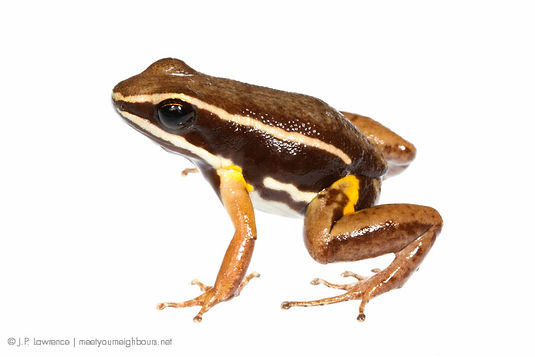Care Articles :
1- Allobates femoralis (B OULENGER , 1884)
courtesy to : www.dendrobase.de/index.php
Species :
1- Allobates femoralis
common name brilliant-thighed poison frog, brilliant-thighed poison-arrow frog
Boulenger, 1884










From Wikipedia, the free encyclopedia
Allobates femoralis (common name brilliant-thighed poison frog, brilliant-thighed poison-arrow frog) is a species of frog in the family Aromobatidae.[2][3] It is found in Bolivia, Brazil, Colombia, Ecuador, French Guiana, Guyana, Peru, and Suriname. Its natural habitat is tropical lowland forests.
Allobates femoralis
Conservation status :
Least Concern (IUCN 3.1)[1]
Scientific classification :
Kingdom:Animalia
Phylum:Chordata
Class:Amphibia
Order:Anura
Family:Aromobatidae
Genus:Allobates
Species:A. femoralis
Binomial name :
Allobates femoralis
(Boulenger, 1884)[1]
Description :
Allobates femoralis is a small frog, the males growing to 28 to 33 mm (1.1 to 1.3 in) in length and the females being marginally larger. The back is dark brown or black and the limbs dark brown. The throat is black and the belly is white, variously marked with black. A pale brown dorso-lateral stripe runs from the snout to the base of the legs and an intermittent white ventro-lateral line runs from the snout to the arm and onwards to the leg. There is an orange-yellow patch behind the arm and a half-moon shaped orange patch on the outside of the thigh. A. femoralis resembles Lithodytes lineatus in general appearance, but the latter has a dorso-lateral line encircling the back, legs barred with dark and light bands of colour, and two or more orange patches on each thigh.[4]
Distribution map
Distribution and habitat :
Allobates femoralis occurs in the Amazon Basin and tropical eastern South America. Its range includes Guyana, Suriname, French Guiana and Brazil, and the eastern parts of Colombia, Ecuador, Peru and Bolivia. A single reported sighting in Venezuela may have referred to Ameerega picta. It is found on the forest floor, usually at elevations below 300 m (1,000 ft), but in Colombia and Ecuador occurs at altitudes of up to 1,000 m (3,300 ft).[1]
Allobates femoralis
Biology :
Allobates femoralis is a terrestrial frog species active during the day. It feeds on small insects such as beetles, crickets, roaches and ants; the juveniles largely feed on springtails. Breeding takes place between November and April, peaking in January or February. The males are territorial and court females for two or three days before a clutch of between about eight to seventeen eggs is laid in a nest among fallen leaves. The male guards the eggs, and after they have hatched, he carries the tadpoles to pools of water on his back.[4]
Status :
The IUCN lists Allobates femoralis as being of "Least Concern". This is because it has a wide range and is common throughout much of that range, it is tolerant of some degree of modification of its habitat, its population seems to be steady and no particular threats to it have been identified.
For the external links , refrences click here to read the full wikipedia article
Video :
Allobates femoralis sp (www.biotabrasil.com.br) (Video por Guia de Sapos da Reserva Ducke)
Synonyms:
Allobates femoralis (G RANT , F ROST , ALDWELL C , G AGLIARDO , H ADDAD , K OK , M EANS , N OONAN , S CHARGEL & W HEELER , 2006)
Allobates femoralis ( Z IMMERMANN & Z IMMERMANN , 1988)
Epipedobates femoralis (M YERS , 1987)
Dendrobates femoralis (M YERS , D ALY& M ALKIN , 1978)
Phyllobates femoralis (B ARBOR & N OBLE , 1920)
Prostherapis femoralis (B OULENGER , 1884)
sensu FROST , 2006
English name: Brilliant-thighed Poison Frog
Classification:
Amphibia-> Anura-> Dendrobatoidea-> Aromobatidae -> Allobatinae-> Allobates -> Allobates femoralis (B OULENGER , 1884)
size
25-38mm, females are much bigger
Grooming:
Granulated back and top of the hind legs. Back dark brown, laterally gold-yellow or white stripes. Flanks are black, including another white stripe. The belly is brown-black. The first toe is longer than the second.
Variation:
Ecuador, Peru:
upper margin gold-yellow, lower margin blue-white, belly black-brown
Brazil, Guyana:
upper margin white, lower margin silver-white, abdomen gray with blue marbling
General behavior:
Bodenbewohner, but also likes to climb to call
Utterance (vocalization):
high long vibrating call, for about 5 seconds
Type find location of the first description
Lectotype of S ILVERSTONE , 1976: "Yurimaguas, Huallaga River, [Loreto,] Northern Peru"
sensu F ROST , 2007
Distribution:
Guyana, Suriname, French Guyana,
course of the Amazon in Colombia,
Ecuador, Peru, Bolivia, Brazil
at altitudes up to 600m


Biotope:
Lives in lowland rainforests on the ground,
especially in the foliage layer.
Males also climb on plants to call.
Attitude in the terrarium
Terrarium / Facility:
Rainforest terrarium from 50x50x50cm
automatic irrigation and fog plant recommended
temperatures:
25-28 ° C, drop by 3-4 ° C at night
Annual variation: minimal (1-2 ° C)
Humidity:
70-80%, at noon to 70%, morning and evening 100% (fog)
Nutrition:
Usual small food animals such as Drosophila, micro-crickets, small wax maggots, springtails, meadow plankton
Tips for breeding:
Breeding is possible in the terrarium, males transport the burbot to waterholes, like leaves on the ground
Photos :






For more information about resources for the above article .. click here
Videos :
- dissolve.com/video/Brilliant-thighed-poison-arrow-frog-Allobates-femoralis
- dissolve.com/video/Brilliant-thighed-poison-arrow-frog-Allobates-femoralis
- www.dailymotion.com/video/x37m3qs
- www.shutterstock.com -spotted-thighed-poison-frog-allobates-femoralis-male-calling
Rã-de-coxa-brilhante (Allobates femoralis)
Allobates_femoralis2.mov
Madagascar Dart frogs
Aromobatidae :
-
Allobatinae
-
Anomaloglossinae
-
Aromobatinae
South America Dart Frogs - Species
Dendrobatidae :
-
Colostethinae
-
Dendrobatinae
-
Hyloxalinae
Species :